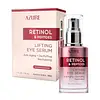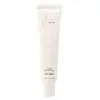What's inside
What's inside
 Key Ingredients
Key Ingredients

 Benefits
Benefits

 Concerns
Concerns

 Ingredients Side-by-side
Ingredients Side-by-side

Water
Skin ConditioningGlycerin
HumectantPropylene Glycol
HumectantBetaine
HumectantSoluble Collagen
HumectantRetinol
Skin ConditioningCopper Tripeptide-1
Skin ConditioningAcetyl Hexapeptide-8
HumectantPalmitoyl Pentapeptide-4
Skin ConditioningSodium Hyaluronate
HumectantPanthenol
Skin ConditioningMacadamia Ternifolia Seed Oil
EmollientBrassica Campestris Sterols
EmollientCeteth-3
EmulsifyingCeteth-5
EmulsifyingTocopheryl Acetate
AntioxidantPotassium Cetyl Phosphate
EmulsifyingBeta-Glucan
Skin ConditioningHydroxyethyl Urea
HumectantAloe Barbadensis Leaf Extract
EmollientButylene Glycol
HumectantHydrogenated Lecithin
EmulsifyingSodium Ascorbyl Phosphate
AntioxidantPolyglyceryl-10 Oleate
Skin ConditioningCaprylic/Capric Triglyceride
MaskingCholesterol
EmollientPolysorbate 20
EmulsifyingPEG-60 Hydrogenated Castor Oil
EmulsifyingGlyceryl Acrylate/Acrylic Acid Copolymer
HumectantAlcohol
AntimicrobialEthylhexylglycerin
Skin Conditioning1,2-Hexanediol
Skin ConditioningPhenoxyethanol
PreservativeParfum
MaskingWater, Glycerin, Propylene Glycol, Betaine, Soluble Collagen, Retinol, Copper Tripeptide-1, Acetyl Hexapeptide-8, Palmitoyl Pentapeptide-4, Sodium Hyaluronate, Panthenol, Macadamia Ternifolia Seed Oil, Brassica Campestris Sterols, Ceteth-3, Ceteth-5, Tocopheryl Acetate, Potassium Cetyl Phosphate, Beta-Glucan, Hydroxyethyl Urea, Aloe Barbadensis Leaf Extract, Butylene Glycol, Hydrogenated Lecithin, Sodium Ascorbyl Phosphate, Polyglyceryl-10 Oleate, Caprylic/Capric Triglyceride, Cholesterol, Polysorbate 20, PEG-60 Hydrogenated Castor Oil, Glyceryl Acrylate/Acrylic Acid Copolymer, Alcohol, Ethylhexylglycerin, 1,2-Hexanediol, Phenoxyethanol, Parfum
Water
Skin ConditioningGlycerin
HumectantCaprylic/Capric Triglyceride
MaskingButylene Glycol
HumectantCetyl Ethylhexanoate
EmollientHydrogenated Polydecene
EmollientNiacinamide
SmoothingDimethicone
EmollientCetearyl Alcohol
EmollientGlyceryl Stearate Se
EmulsifyingMethylpropanediol
SolventPolyglyceryl-3 Methylglucose Distearate
EmulsifyingButyrospermum Parkii Butter
Skin ConditioningPalmitic Acid
EmollientDimethicone/Vinyl Dimethicone Crosspolymer
Skin ConditioningStearic Acid
CleansingArginine
MaskingCarbomer
Emulsion StabilisingBetaine
HumectantWine Extract
AntioxidantCarica Papaya Fruit Extract
Skin ConditioningCitrus Aurantifolia Fruit Extract
Skin ConditioningXanthan Gum
EmulsifyingAdenosine
Skin ConditioningParfum
MaskingDisodium EDTA
Tocopheryl Acetate
Antioxidant1,2-Hexanediol
Skin ConditioningMyristic Acid
CleansingArachidic Acid
CleansingPaeonia Lactiflora Root Extract
Skin ConditioningGlycyrrhiza Glabra Root Extract
BleachingPolygonum Multiflorum Root Extract
Skin ConditioningPhellinus Linteus Extract
Skin ConditioningMorus Alba Bark Extract
Skin ConditioningSophora Flavescens Root Extract
AntioxidantCimicifuga Racemosa Root Extract
AntimicrobialSesamum Indicum Seed Extract
Skin ConditioningAngelica Gigas Root Extract
Skin ConditioningScutellaria Baicalensis Root Extract
AstringentOleic Acid
EmollientSalix Alba Bark Extract
AstringentEthylhexylglycerin
Skin ConditioningWater, Glycerin, Caprylic/Capric Triglyceride, Butylene Glycol, Cetyl Ethylhexanoate, Hydrogenated Polydecene, Niacinamide, Dimethicone, Cetearyl Alcohol, Glyceryl Stearate Se, Methylpropanediol, Polyglyceryl-3 Methylglucose Distearate, Butyrospermum Parkii Butter, Palmitic Acid, Dimethicone/Vinyl Dimethicone Crosspolymer, Stearic Acid, Arginine, Carbomer, Betaine, Wine Extract, Carica Papaya Fruit Extract, Citrus Aurantifolia Fruit Extract, Xanthan Gum, Adenosine, Parfum, Disodium EDTA, Tocopheryl Acetate, 1,2-Hexanediol, Myristic Acid, Arachidic Acid, Paeonia Lactiflora Root Extract, Glycyrrhiza Glabra Root Extract, Polygonum Multiflorum Root Extract, Phellinus Linteus Extract, Morus Alba Bark Extract, Sophora Flavescens Root Extract, Cimicifuga Racemosa Root Extract, Sesamum Indicum Seed Extract, Angelica Gigas Root Extract, Scutellaria Baicalensis Root Extract, Oleic Acid, Salix Alba Bark Extract, Ethylhexylglycerin
 Reviews
Reviews

Ingredients Explained
These ingredients are found in both products.
Ingredients higher up in an ingredient list are typically present in a larger amount.
1,2-Hexanediol is a synthetic liquid and another multi-functional powerhouse.
It is a:
- Humectant, drawing moisture into the skin
- Emollient, helping to soften skin
- Solvent, dispersing and stabilizing formulas
- Preservative booster, enhancing the antimicrobial activity of other preservatives
Betaine is a common humectant (a substance that promotes retention of moisture). It's known to be gentle on the skin and can help balance hydration.
This ingredient is best for improving hydration and soothing irritated skin. Studies also show it helps even out skin tone.
Fun fact: Betaine is naturally created in the skin and body. The kind found within cosmetic products can be either plant-derived or synthetic.
Another name for betaine is trimethylglycine.
Learn more about BetaineButylene Glycol (or BG) is used within cosmetic products for a few different reasons:
Overall, Butylene Glycol is a safe and well-rounded ingredient that works well with other ingredients.
Though this ingredient works well with most skin types, some people with sensitive skin may experience a reaction such as allergic rashes, closed comedones, or itchiness.
Learn more about Butylene GlycolThis ingredient is an emollient, solvent, and texture enhancer. It is considered a skin-softener by helping the skin prevent moisture loss.
It helps thicken a product's formula and makes it easier to spread by dissolving clumping compounds.
Caprylic Triglyceride is made by combining glycerin with coconut oil, forming a clear liquid.
While there is an assumption Caprylic Triglyceride can clog pores due to it being derived from coconut oil, there is no research supporting this.
Learn more about Caprylic/Capric TriglycerideEthylhexylglycerin (we can't pronounce this either) is commonly used as a preservative and skin softener. It is derived from glyceryl.
You might see Ethylhexylglycerin often paired with other preservatives such as phenoxyethanol. Ethylhexylglycerin has been found to increase the effectiveness of these other preservatives.
Glycerin is already naturally found in your skin. It helps moisturize and protect your skin.
A study from 2016 found glycerin to be more effective as a humectant than AHAs and hyaluronic acid.
As a humectant, it helps the skin stay hydrated by pulling moisture to your skin. The low molecular weight of glycerin allows it to pull moisture into the deeper layers of your skin.
Hydrated skin improves your skin barrier; Your skin barrier helps protect against irritants and bacteria.
Glycerin has also been found to have antimicrobial and antiviral properties. Due to these properties, glycerin is often used in wound and burn treatments.
In cosmetics, glycerin is usually derived from plants such as soybean or palm. However, it can also be sourced from animals, such as tallow or animal fat.
This ingredient is organic, colorless, odorless, and non-toxic.
Glycerin is the name for this ingredient in American English. British English uses Glycerol/Glycerine.
Learn more about GlycerinParfum is a catch-all term for an ingredient or more that is used to give a scent to products.
Also called "fragrance", this ingredient can be a blend of hundreds of chemicals or plant oils. This means every product with "fragrance" or "parfum" in the ingredients list is a different mixture.
For instance, Habanolide is a proprietary trade name for a specific aroma chemical. When used as a fragrance ingredient in cosmetics, most aroma chemicals fall under the broad labeling category of “FRAGRANCE” or “PARFUM” according to EU and US regulations.
The term 'parfum' or 'fragrance' is not regulated in many countries. In many cases, it is up to the brand to define this term.
For instance, many brands choose to label themselves as "fragrance-free" because they are not using synthetic fragrances. However, their products may still contain ingredients such as essential oils that are considered a fragrance by INCI standards.
One example is Calendula flower extract. Calendula is an essential oil that still imparts a scent or 'fragrance'.
Depending on the blend, the ingredients in the mixture can cause allergies and sensitivities on the skin. Some ingredients that are known EU allergens include linalool and citronellol.
Parfum can also be used to mask or cover an unpleasant scent.
The bottom line is: not all fragrances/parfum/ingredients are created equally. If you are worried about fragrances, we recommend taking a closer look at an ingredient. And of course, we always recommend speaking with a professional.
Learn more about ParfumTocopheryl Acetate is AKA Vitamin E. It is an antioxidant and protects your skin from free radicals. Free radicals damage the skin by breaking down collagen.
One study found using Tocopheryl Acetate with Vitamin C decreased the number of sunburned cells.
Tocopheryl Acetate is commonly found in both skincare and dietary supplements.
Learn more about Tocopheryl AcetateWater. It's the most common cosmetic ingredient of all. You'll usually see it at the top of ingredient lists, meaning that it makes up the largest part of the product.
So why is it so popular? Water most often acts as a solvent - this means that it helps dissolve other ingredients into the formulation.
You'll also recognize water as that liquid we all need to stay alive. If you see this, drink a glass of water. Stay hydrated!
Learn more about Water